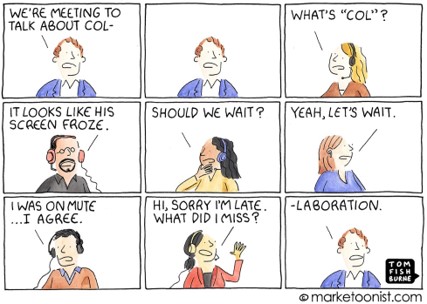Virtual collaboration isn’t just for dedicated remote workers anymore.
People aren’t necessarily “working from home” but they are “at home, trying to work” due to COVID-19 circumstances. How can this remote experience seamlessly transition from physical interactions? The answer is virtual collaboration – but only if done correctly.
Whether you’re a teacher, manager, student, or CEO, knowing what makes virtual collaboration successful can help improve this “new normal” way of working. To get there, we can’t forget the values emotional intelligence, education, and empathy each bring.


Emotional intelligence
Business school professor Amy Edmondson’s Brightline Initiative TED Talk reflects on the concept of teaming: a situation where strangers come together quickly to solve problems despite distance, expertise, time zones, and status. While your colleagues and coworkers aren’t complete strangers, these unprecedented times and working conditions certainly are.
So, how can teaming solve this issue? Edmondson shares three key qualities that have contributed to teaming success:
- Humble in the face of challenges ahead
- Curious about what others bring
- Willing to take risks to learn quickly
When a group of strangers (or a group of people working in strange conditions) all do their best to exercise emotional intelligence and stay humble by creating situational humility, remain curious by embracing diverse opinions, and are willing to take risks to learn quickly, then problem solving in a virtual world will be easier than ever before.
Self-education
Edmondson’s TED Talk also touches on the basic human challenge: it’s hard to learn if you already know. Since it’s easier to stick with solutions that are familiar and fill short-term needs, you might wonder: why do I need to chat and share files with my team via Microsoft Teams instead of using my own personal Dropbox account? It can be confusing enough for many that are forced to work remotely, but using disparate software to communicate, edit and share files will only make it more challenging.
Unfortunately, this mentality of sticking to what you know can hinder virtual collaboration. It’s worth taking the extra time to learn what technology is not only best for you and your team to use in that moment, but most importantly, what is the best solution that your organization has standardized on for your communication platform.
Learning, understanding, and implementing technology the right way will help enhance your virtual collaboration experience. There are many online resources for collaboration platforms. Here’s a few from Microsoft Teams to kick-start your education:
- Success with Teams
- Journey from Skype for Business to Teams
- Admin training for Microsoft Teams
- Admin quick start guide
- Meetings in Microsoft Teams
- Understand calling in Microsoft Teams
- Microsoft Teams Direct Routing
Empathy
Edmondson’s TED Talk leaves us with an Abraham Lincoln quote: “I don’t like that man. I must get to know him better.”
Now, more than ever, we’re meeting with different people in different ways. It’s important to stay patient, open, and flexible throughout the day. Having the right temperament and attitude when collaborating virtually is essential to seeing its full potential and true success.
Dogs will bark, sirens will sound off, and chances are you might disagree with a coworker or colleague every now and then. Instead of losing your patience or trust in your team, practice empathy in meetings and think of your colleagues not as your competition, but as key ingredients for achieving virtual collaboration.
“In our silos we can get things done,” says Edmondson. “But when we step back, reach out, and reach across, miracles can happen.”



